
Cryptocurrency Registration and Usage Guide
Table of Contents
1. Introduction to Cryptocurrency
2. Understanding Cryptocurrency Wallets
3. Choosing a Cryptocurrency Exchange
4. The Registration Process
5. Verifying Your Identity
6. Depositing Funds
7. Trading Cryptocurrency
8. Storing Cryptocurrency Securely
9. Best Practices for Safe Usage
10. Conclusion
1. Introduction to Cryptocurrency
Cryptocurrency, a digital or virtual form of currency, has gained significant traction over the past decade. It operates independently of a central bank and relies on a decentralized system called blockchain. Cryptocurrency offers users a secure, transparent, and often borderless means of conducting transactions.
2. Understanding Cryptocurrency Wallets
Before registering and using cryptocurrency, it is crucial to understand what a wallet is. A cryptocurrency wallet is a digital storage solution that allows users to send, receive, and store their digital assets. There are two main types of wallets: hot wallets and cold wallets. Hot wallets are connected to the internet and offer convenience but may be more susceptible to hacking. Cold wallets, on the other hand, are offline and provide enhanced security.
3. Choosing a Cryptocurrency Exchange
To buy and sell cryptocurrency, you need to choose a reliable cryptocurrency exchange. An exchange is a platform where users can trade various cryptocurrencies for fiat currencies or other digital currencies. When selecting an exchange, consider factors such as fees, security measures, customer support, and the range of available cryptocurrencies.
4. The Registration Process
The registration process for a cryptocurrency exchange typically involves the following steps:
- Visit the exchange's website and click on the "Sign Up" or "Register" button.
- Fill in the required personal information, such as your name, email address, and phone number.
- Create a strong password for your account.
- Agree to the terms and conditions of the exchange.
- Complete the registration process by verifying your email or phone number.
5. Verifying Your Identity
To comply with anti-money laundering (AML) and know your customer (KYC) regulations, most exchanges require users to verify their identity. This process usually involves uploading a government-issued ID, proof of address, and a selfie with the ID. The exchange will review your documents and may request additional information if needed.
6. Depositing Funds
Once your account is verified, you can deposit funds into your exchange account. The most common methods for depositing funds include bank transfers, credit/debit cards, and other payment methods supported by the exchange. Be aware of any fees associated with depositing funds.
7. Trading Cryptocurrency
Trading cryptocurrency involves buying and selling digital assets on the exchange. To get started, you need to:
- Navigate to the trading section of the exchange.
- Choose the cryptocurrency you want to trade.
- Select a trading pair (e.g., BTC/USD).
- Enter the amount of cryptocurrency or fiat currency you wish to trade.
- Place a buy or sell order.
- Monitor your trades and adjust your strategy as needed.
8. Storing Cryptocurrency Securely
After trading, it is essential to store your cryptocurrency securely. Here are some tips:
- Use a hardware wallet for long-term storage.
- Keep a backup of your wallet's private keys or recovery phrase.
- Use a reputable software wallet for daily transactions.
- Avoid storing large amounts of cryptocurrency on exchanges.
- Be cautious of phishing scams and malware.
9. Best Practices for Safe Usage
To ensure safe usage of cryptocurrency, follow these best practices:
- Keep your private keys and recovery phrases secure.
- Use strong, unique passwords for all accounts.
- Enable two-factor authentication (2FA) on all accounts.
- Stay informed about the latest security threats and updates.
- Be wary of unsolicited requests for your personal information.
10. Conclusion
Registering and using cryptocurrency can be a rewarding experience, but it requires careful consideration and responsible behavior. By understanding the basics, choosing a reliable exchange, and following best practices for security, you can navigate the world of cryptocurrency with confidence.
Questions and Answers
1. What is a blockchain?
- A blockchain is a decentralized digital ledger that records transactions across multiple computers in a secure, transparent, and tamper-proof manner.
2. Can I use cryptocurrency to make purchases online?
- Yes, many online merchants accept cryptocurrency as a payment method.
3. How do I know if a cryptocurrency exchange is reputable?
- Research the exchange's reputation, security measures, customer reviews, and regulatory compliance.
4. What is the difference between a private key and a public key?
- A private key is used to access and control your cryptocurrency, while a public key is used to receive cryptocurrency.
5. What is a wallet address?
- A wallet address is a unique string of characters that serves as the identifier for your cryptocurrency wallet.
6. How long does it take to verify my identity on an exchange?
- Verification times vary by exchange, but it typically takes a few hours to a few days.
7. Are there any risks associated with using cryptocurrency?
- Yes, there are risks, including price volatility, security threats, and regulatory changes.
8. How can I protect my cryptocurrency from hackers?
- Use strong passwords, enable 2FA, store your cryptocurrency in a secure wallet, and stay informed about the latest security threats.
9. Can I trade cryptocurrency on my mobile device?
- Yes, many exchanges offer mobile apps that allow you to trade and manage your cryptocurrency portfolio on the go.
10. What should I do if I lose access to my cryptocurrency wallet?
- If you lose access to your wallet, you may need to contact the wallet provider or use the recovery phrase to regain access. Be cautious of scams in this situation.